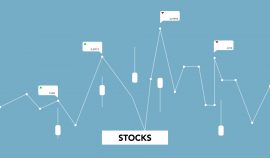
Transactions drive stock market successes and failures. Financial analysts earn their living by suggesting the best times to execute on a stock market transaction. To that end, they issue “ratings” that argue whether it’s the right time to buy or sell shares in a certain commodity.
But along with “buy” and “sell,” analysts also issue “hold” recommendations. And even though the “hold stock” definition is exactly what it sounds like, it’s still confusing to some novices in the stock market.
What is stock holding? What does it mean to hold a stock? What does a “hold” rating actually say about a commodity that has it? And how do you hold a stock? Gorilla Trades takes a closer look.

What Does “Hold” Mean in the Stock Market?
To understand the stock holding definition, let’s quickly define what the other two ratings mean.
When an analyst issues a “buy” rating on a certain stock, it’s a suggestion that now is the right time to buy shares in the commodity. The analyst believes that the stock’s share price will move upward in the near future and will pay investors off handsomely if they jump in now.
But when they recommend to “sell” shares in a stock, the analyst expects its share price to go down from its current level. They believe there’s enough compelling information to indicate the company is in some sort of trouble and that investors are better off booting it out of their portfolios.
Some stock market resources kick their “buy” and “sell” ratings up another level by adding “strong” recommendations: “strong buy” and “strong sell.” Those ratings show the analysts believe there’s some urgency to get in or out of certain positions now.
Now, then, what is “hold” in the stock market?
Simply put, it means to do nothing. If you’re thinking about buying a certain stock, don’t. If you’re thinking about selling a certain stock you already have, don’t do that, either.
That seems easy enough, right? Whatever your current position may be on a certain commodity, keep it. Stay the course.
But the suggested inaction can be perplexing to some investors. There’s a clear message with “buy” and “sell” ratings. You need to either jump in or out because analysts see trends or patterns that support estimates of eventual upward or downward movement in share price. With “buy” and “sell” ratings, people obviously believe something is going to happen.
So what does “hold” mean in stocks? Will the share price just stay the same? Does it mean you just need to wait for further information? How long are you supposed to hold onto the stock? How long do you have to wait to buy the stock?
What Is Holding a Stock? What Does a Hold Rating Mean?
Every analyst uses different metrics to decide whether a stock should be held or not. But a “hold” rating doesn’t necessarily mean that the stock price will just flatline for the foreseeable future. It just won’t move very much.
A stock with a “hold” rating is expected to perform in line with the general movement of the S&P 500 or Dow Jones Industrial Index in the short to medium term.
The average annual stock market return, going back 100 years, is around 10%. So many analysts believe a “hold” rating on a certain commodity indicates a belief that the stock price will go up around 10% over the next year to year and a half.
On the other hand, analysts might believe a hold rating says the stock price will go down by 10% over the next 12 to 16 months. While that’s significant, it doesn’t mean unloading the stock is worth the trouble. The company itself might be fundamentally sound but may face certain economic conditions that will keep it down for a little bit.
Generally speaking, a hold rating means the stock isn’t going to overperform or underperform to an extent that makes it a must-buy or must-sell. If you already have a position in the stock, there’s not much to gain from selling it. If you don’t have a position, it’s not going to move the needle enough to buy it at this time.
There are nuances to a hold rating, of course. Some stock market watchers believe “hold” is little more than a watered-down “sell” rating. If there’s little to suggest that the share price is going to move dramatically upward, why not sell it and reallocate the capital toward a commodity that will?
Others believe a “hold” rating is a sign that the stock isn’t going to be a barnburner anytime soon, but it’s not necessarily a bad idea to buy into it. It may do just well enough to serve as a “bedrock” stock that poses no consequential risk to your portfolio.

What’s Behind a Hold Rating?
What factors play into a “hold” rating? Every analyst has different methods for suggesting it. But the most common factors are middling expectations and uncertainty.
The company may be making its projected earnings but may not have any new products on the horizon to generate new sales. Perhaps its revenue may have fallen short for a couple of consecutive quarters, but the company is known for weathering such storms in the past.
Lack of clarity about a company can also play into a hold rating. Investment experts don’t like uncertainty. If an established company is going through problems with its executive board or is facing a delay in delivering a new product, analysts may prefer to take a “wait and see” approach. This amounts to a hold rating.
What Is “Buy and Hold”?
One variation on the “hold” strategy is “buy and hold.” When an analyst suggests this, they’re telling you to take a position on the stock now and plan on keeping it in your portfolio for an extended time.
Unlike a straight “hold” rating, “buy and hold” is focused on the long term. Experts think that a company with a “buy and hold” designation is positioned for long-term growth and stability. If you make a sufficient investment now, the stock will grow at a dependable rate for years (typically at least five).
“Buy and hold” is a passive investment strategy. Its proponents believe it can provide a solid foundation of bedrock stocks that will generate exponential growth over the long term.
Indeed, this is a favorite strategy of Warren Buffett, who appears to be doing pretty well for himself. Active investors, meanwhile, think a “buy and hold” strategy doesn’t allow stockholders to be nimble or take advantage of short-term price fluctuations.
In all truth, a diversified portfolio is better positioned for success. So a few “buy and hold” stocks are nice to have alongside those with more short-term growth potential.
How to Hold Stocks
Right now, somebody is searching for the phrase “how do you hold a stock” on the internet. And they mean the question sincerely, so we’re inclined to answer it, even though the answer is profoundly simple.
If you currently own a stock that has a “hold” rating, you do nothing. Don’t sell it. Just keep an eye on it, which you should be doing with all of your stock holdings anyway.
If you don’t own a stock that has a “hold” rating, also do nothing. Don’t buy it.
Keep in mind, though, that “hold” ratings are in the eye of the beholder (forgive the pun). No analyst is perfect, and all experts should be open to scrutiny over their rating decisions. Whatever ratings they issue, take time to understand the reasoning behind them.

Get Stock Investment Tips at Gorilla Trades
Gorilla Trades helps all our clients to make transaction decisions that earn real profits. To find out more, sign up for a free trial.
